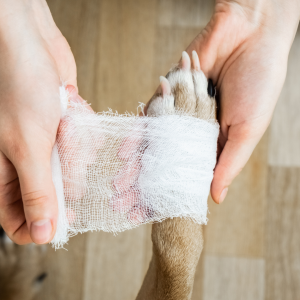 That dark gray bottle of Hydrogen Peroxide has long been a staple in first aid kits and medicine cabinets. The foaming bubbles are a must-have for cleaning minor scratches and wounds, on humans and dogs alike! However, research in recent years has discovered that peroxide not only kills any bacteria at the wound site, but can also damage healthy skin as well. This can greatly impair wound healing, as well as make your pet more susceptible to infection. Veterinarians now recommend that Hydrogen Peroxide is only used under a veterinarian’s recommendation, and typically only orally to induce vomiting.
That dark gray bottle of Hydrogen Peroxide has long been a staple in first aid kits and medicine cabinets. The foaming bubbles are a must-have for cleaning minor scratches and wounds, on humans and dogs alike! However, research in recent years has discovered that peroxide not only kills any bacteria at the wound site, but can also damage healthy skin as well. This can greatly impair wound healing, as well as make your pet more susceptible to infection. Veterinarians now recommend that Hydrogen Peroxide is only used under a veterinarian’s recommendation, and typically only orally to induce vomiting.
Alternatives to Hydrogen Peroxide are as follows:
- Warm tap water. This is the most highly recommended method for cleaning wounds on dogs! Simply wet a cloth with warm water, wring out any excess, and apply to the wound. Make sure to re-wet the cloth as it cools down. You can repeat this multiple times a day for about 5-10 minutes. This method also doubles as a warm compress, which can assist in relieving pain if the wound site is swollen or irritated.
- Saline solution, in first aid packs or lens cleaning solution. Using saline solution is a great way to ensure that the wound is truly clean. Cleaning a wound with saline can be done the exact same way as the water method. Don’t have any saline at home? Try mixing 1 teaspoon of salt or Epsom salt with 2 cups of water.
- Diluted betadine. Betadine is a great way to ensure that your dog’s wound is properly flushed. A diluted mixture can be made from 1 ounce of betadine and 1 quart of water. Since betadine works best with flushing a wound, the mixture should be poured over the wound, rather than pressed into.
- Pet-safe antibacterial ointment. Though not the most efficient way to clean a wound, applying a triple antibiotic, such as Neosporin, can help in ensuring that your dog’s wound stays clean. It is important to note that although ingesting Neosporin won’t hurt your dog, the licking motion can irritate the wound. Always make sure to monitor your pup and be ready to change up your wound care whenever needed.
- Although the days of using foamy Hydrogen Peroxide may be in the past, there are many great, on-hand methods to clean your dog’s wound. And be sure not to toss that Peroxide out! You’ll never know what curious canines will get their paws on next.
